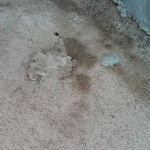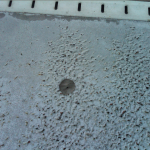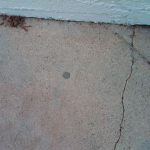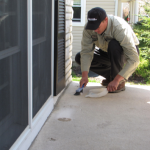One of the first things I always notice on any home or structure are patches from termite work. My boys like to be the first to spot them if we go out to eat or are at the mall, they think they’ve one upped me. I just smile and say “what chemical was used?” and their faces go blank while I proceed to say it was a Dursban mix from the summer of 85. Of course I can’t tell what was used but they don’t know that, shhh, our little secret!
Patch marks can tell you a lot about a home but they can also tell you a little bit about the technician. Some just glob the cement and leave a mini stalagmite formation while others smear the mix making a 1/4 inch hole look like a 3 inch one. You can see who was in a hurry and who might have taken too much time because the cement was half dried. Some patches drop through and you may have several holes that the ants are now using and every once in awhile you’ll find the sheared off drill bit that bound and broke. That is one patch that’ll never come out.
Patching drill holes is tedious work and by the time you get to it you’re already tired and sore from the hard drilling, trenching and  shooting the job. I can see why techs want to hurry and wrap things up but to me it is the only visible part of your job that people will see so why not take the time to try and make it look good? Recently I came across 2 different homes that had great patch work done. One job was done years ago and the hole size was 1/4 inch. The other was in the last 5 years and they used a 1/2 inch bit to drill. Both were done very neatly and the patches were perfect. Of course the homeowners weren’t overly impressed but isn’t that the way it always is? Put sloppy patchwork in however and you might hear some different opinions.
shooting the job. I can see why techs want to hurry and wrap things up but to me it is the only visible part of your job that people will see so why not take the time to try and make it look good? Recently I came across 2 different homes that had great patch work done. One job was done years ago and the hole size was 1/4 inch. The other was in the last 5 years and they used a 1/2 inch bit to drill. Both were done very neatly and the patches were perfect. Of course the homeowners weren’t overly impressed but isn’t that the way it always is? Put sloppy patchwork in however and you might hear some different opinions.
Tips on patching termite holes
 First I always try to use the same cement that piles up as I drill the holes. I might buy one small pail of cement per year and actually I end up having more than what I need at the end of most jobs. I find that this cement will blend better in color once it dries and it’s already a fine powder due to my hammer drill so you don’t get any clumps in the mix. The trick for this is to sweep up before you shoot and leave any holes that have excess dirt or leaves in the cement dust.
First I always try to use the same cement that piles up as I drill the holes. I might buy one small pail of cement per year and actually I end up having more than what I need at the end of most jobs. I find that this cement will blend better in color once it dries and it’s already a fine powder due to my hammer drill so you don’t get any clumps in the mix. The trick for this is to sweep up before you shoot and leave any holes that have excess dirt or leaves in the cement dust.
Next, don’t add to much water. Pour in a little at a time until you get a very pliable but thick slurry, too thin add dust, too thick add water. Use your hand to mix it up and make sure to run your finger tip around the bottom rim of your small mixing bucket. This gets any dry dust into the mix rather than at the end when you need just a little bit and all you get is that unmixed dust. I also wear a latex glove for the hand that handles the cement. I don’t know what ‘cement poisoning’ is but I’ve heard you can get it by excess contact so it’s a glove for me.
I then take only a small handful and knead it just a bit in my palm and force up just enough by squeezing it to my thumb and fore finger. Doing this makes it like a small hot dog and you place the end into the hole and then with a push and wipe motion you create your patch. At times you need to repeat this on the same hole or you may leave a small crack on one side but with a quick swipe you can make sure the entire hole is covered. Drill holes in the wall are a little trickier but basically the same process, brick or stone veneers use much more cement and tend to be sloppier but still hide very well.
Doing this makes it like a small hot dog and you place the end into the hole and then with a push and wipe motion you create your patch. At times you need to repeat this on the same hole or you may leave a small crack on one side but with a quick swipe you can make sure the entire hole is covered. Drill holes in the wall are a little trickier but basically the same process, brick or stone veneers use much more cement and tend to be sloppier but still hide very well.
The final step is to sweep one last time, this puts that finishing touch across the top and makes the patch smooth. If any patches are weak or to thin the broom might pop the patch down through the hole and you’ll need to fix it. (Better to see it now then get the call later) I also use this time to make sure I got all the holes patched and put back any items I had to move.
Quick note
 For holes in cut or glued carpet you might consider a shop vac even after you’ve swept. Leaving even just a little dust in the cut and drilled hole will quickly dry out your mix and make raised bumps and your carpet won’t lay or glue back down nicely at all. The same goes for linoleum chips, tile or wood flooring that you’ve cut plugs out of.
For holes in cut or glued carpet you might consider a shop vac even after you’ve swept. Leaving even just a little dust in the cut and drilled hole will quickly dry out your mix and make raised bumps and your carpet won’t lay or glue back down nicely at all. The same goes for linoleum chips, tile or wood flooring that you’ve cut plugs out of.
They do sell plastic plugs but I never use them and I hate retreating when they have been installed. I like that you can zip right through them with a drill but cement plugs are easy for that too. Plastic plugs are a bite to take out and impossible to re-patch over. Also they are difficult to paint over should the home owner ever wish to paint or cover the floor or wall.
You do need to move fast when patching because the mix dries quickly and don’t overly knead what’s in your hand as that also quickens the drying process. No one is Picasso on their first few patch jobs but with a little practice you can master the perfect patch.




